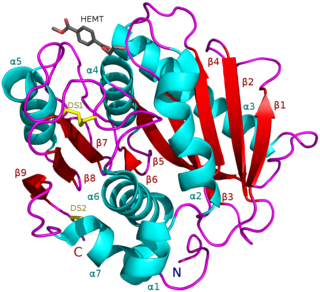Biological augmentation is the addition of archaea or bacterial cultures required to speed up the rate of degradation of a contaminant. Organisms that originate from contaminated areas may already be able to break down waste, but perhaps inefficiently and slowly.

4-Hydroxybenzoic acid, also known as p-hydroxybenzoic acid (PHBA), is a monohydroxybenzoic acid, a phenolic derivative of benzoic acid. It is a white crystalline solid that is slightly soluble in water and chloroform but more soluble in polar organic solvents such as alcohols and acetone. 4-Hydroxybenzoic acid is primarily known as the basis for the preparation of its esters, known as parabens, which are used as preservatives in cosmetics and some ophthalmic solutions. It is isomeric with 2-hydroxybenzoic acid, known as salicylic acid, a precursor to aspirin, and with 3-hydroxybenzoic acid.
Dehalococcoides is a genus of bacteria within class Dehalococcoidia that obtain energy via the oxidation of hydrogen and subsequent reductive dehalogenation of halogenated organic compounds in a mode of anaerobic respiration called organohalide respiration. They are well known for their great potential to remediate halogenated ethenes and aromatics. They are the only bacteria known to transform highly chlorinated dioxins, PCBs. In addition, they are the only known bacteria to transform tetrachloroethene to ethene.

Delftia is a genus of Gram-negative bacteria that was first isolated from soil in Delft, Netherlands. The species is named after both the city, and in honor of pioneering research in the field of bacteriology that occurred in Delft. Cells in the genus Delftia are rod shaped and straight or slightly curved. Cells occur singly or in pairs, are 0.4–0.8ɥM wide and 2.5–4.1 μm long. Delftia species are motile by flagella, nonsporulating, and chemo-organotrophic.
Delftia acidovorans is a Gram-negative, motile, non-sporulating, rod-shaped bacterium known for its ability to biomineralize gold and bioremediation characteristics. It was first isolated from soil in Delft, Netherlands. The bacterium was originally categorized as Pseudomonas acidovorans and Comamonas acidovorans before being reclassified as Delftia acidovorans.
In enzymology, a terephthalate 1,2-cis-dihydrodiol dehydrogenase (EC 1.3.1.61) is an enzyme that catalyzes the chemical reaction:
In enzymology, a terephthalate 1,2-dioxygenase (EC 1.14.12.15) is an enzyme that catalyzes the chemical reaction
In enzymology, a 4-formylbenzenesulfonate dehydrogenase (EC 1.2.1.62) is an enzyme that catalyzes the chemical reaction

Protocatechuic acid (PCA) is a dihydroxybenzoic acid, a type of phenolic acid. It is a major metabolite of antioxidant polyphenols found in green tea. It has mixed effects on normal and cancer cells in in vitro and in vivo studies. It is produced commercially from vanillin.

3,4-DHSA is an organic compound which is the intermediate product of the metabolism of cholesterol, by the bacteria most commonly responsible for tuberculosis. 3,4-DHSA is an acronym for 3,4-dihydroxy-9,10-seco-androst-1,3,5(10)-triene-9,17-dione, the official name of this substance. It is classified as a secosteroid, since one of the four rings of cholesterol from which it is derived is broken.
Biodegradable additives are additives that enhance the biodegradation of polymers by allowing microorganisms to utilize the carbon within the polymer chain as a source of energy. Biodegradable additives attract microorganisms to the polymer through quorum sensing after biofilm creation on the plastic product. Additives are generally in masterbatch formation that use carrier resins such as polyethylene (PE), polypropylene (PP), polystyrene (PS) or polyethylene terephthalate (PET).
Comamonas thiooxydans is a Gram-negative, rod-shaped bacterium from the genus Comamonas and family Comamonadaceae, which was isolated from a sulfur spring. C. thiooxydans has the ability to oxidize thiosulfate.
Delftia lacustris is a Gram-negative, nonfermentative, motile, rod-shaped bacterium from the family Comamonadaceae, which was isolated from mesotrophic lake water in Denmark. It has the ability to degrade peptidoglycan through chitinase and lysozyme activity.
4,5:9,10-diseco-3-hydroxy-5,9,17-trioxoandrosta-1(10),2-diene-4-oate hydrolase (EC 3.7.1.17, tesD (gene), hsaD (gene)) is an enzyme with systematic name 4,5:9,10-diseco-3-hydroxy-5,9,17-trioxoandrosta-1(10),2-diene-4-oate hydrolase ( (2Z,4Z)-2-hydroxyhexa-2,4-dienoate-forming). This enzyme catalyses the following chemical reaction
Sphingomonas yanoikuyae is a short rod-shaped, strictly aerobic, Gram-negative, non-motile, non-spore-forming, chemoheterotrophic species of bacteria that is yellow or off-white in color. Its type strain is JCM 7371. It is notable for degrading a variety of aromatic compounds including biphenyl, naphthalene, phenanthrene, toluene, m-, and p-xylene. S. yanoikuyae was discovered by Brian Goodman on the southern coast of Papua New Guinea. However, Sphingomonas have a wide distribution across freshwater, seawater, and terrestrial habitats. This is due to the bacteria's ability to grow and survive under low-nutrient conditions as it can utilize a broad range of organic compounds.
Novosphingobium pentaromativorans is a species of high-molecular-mass polycyclic aromatic hydrocarbon-degrading bacterium. It is Gram-negative, yellow-pigmented and halophilic. The genome of the type strain US6-1T has been sequenced, revealing the presence of two plasmids. The larger of these plasmids contains the majority of the aromatic-hydrocarbon degrading genes and has been implicated in studies to play an important role in degrading bicyclic aromatic compounds.This ability to degrade polycyclic aromatic hydrocarbons (PAHs) and alkylated PAHs suggests N. pentaromativorans may be used for bioremediation.
Ideonella sakaiensis is a bacterium from the genus Ideonella and family Comamonadaceae capable of breaking down and consuming the plastic polyethylene terephthalate (PET) using it as both a carbon and energy source. The bacterium was originally isolated from a sediment sample taken outside of a plastic bottle recycling facility in Sakai City, Japan.
Xenophilus azovorans is a bacterium from the genus Xenophilus which has been isolated from soil in Switzerland.

Bioremediation is the process of decontaminating polluted sites through the usage of either endogenous or external microorganism. In situ is a term utilized within a variety of fields meaning "on site" and refers to the location of an event. Within the context of bioremediation, in situ indicates that the location of the bioremediation has occurred at the site of contamination without the translocation of the polluted materials. Bioremediation is used to neutralize pollutants including Hydrocarbons, chlorinated compounds, nitrates, toxic metals and other pollutants through a variety of chemical mechanisms. Microorganism used in the process of bioremediation can either be implanted or cultivated within the site through the application of fertilizers and other nutrients. Common polluted sites targeted by bioremediation are groundwater/aquifers and polluted soils. Aquatic ecosystems affected by oil spills have also shown improvement through the application of bioremediation. The most notable cases being the Deepwater Horizon oil spill in 2010 and the Exxon Valdez oil spill in 1989. Two variations of bioremediation exist defined by the location where the process occurs. Ex situ bioremediation occurs at a location separate from the contaminated site and involves the translocation of the contaminated material. In situ occurs within the site of contamination In situ bioremediation can further be categorized by the metabolism occurring, aerobic and anaerobic, and by the level of human involvement.

PETases are an esterase class of enzymes that catalyze the breakdown (via hydrolysis) of polyethylene terephthalate (PET) plastic to monomeric mono-2-hydroxyethyl terephthalate (MHET). The idealized chemical reaction is:






